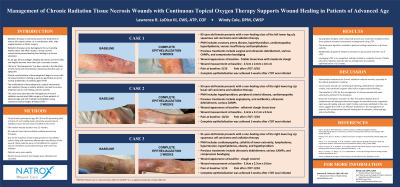Case Series/Study
(CS-045) Management of Chronic Radiation Tissue Necrosis Wounds With Continuous Topical Oxygen Therapy Supports Wound Healing in Patients of Advanced Age

Lawrence LoDico, CWS,ATP,COF
Introduction: Radiation therapy is commonly used in the treatment of various skin cancers alone, or in combination with wide surgical excision. Radiation therapy can be damaging to the surrounding healthy tissue and often results in tissue necrosis compromising wound healing thus leading to a chronic ulceration. This case series describes the management of chronic radiation wounds in three patients of advanced age with additional comorbidities using continuous topical oxygen therapy (cTOT).
Methods: Three patients ages 84, 90, and 93 presenting with a history of non-healing lower extremity wounds due to radiation tissue necrosis were included in this case series. The median wound duration was 12 months. All patients had tried and failed multiple wound care therapies. Due to the existence of skin frailty present in this patient cohort along with extensive inflammation and fibrosis of the wound, these patients were not candidates for surgical closure, therefore conservative therapy with cTOT was initiated. Patients were seen weekly. Wound measurements and images were obtained and recorded.
Results: Having failed several other treatment modalities these radiation wounds in patients with skin frailty and multiple comorbidities were managed with cTOT. cTOT resulted in positive healing outcomes in all 3 patients. Leveraging cTOT in an outpatient setting supported wound closure of these refractory radiation wounds.
Discussion: Standardized treatments for chronic radiation-induced wounds is lacking. Conservative wound care consisting of cleaning, debridement, infection control and nutritional support often fail to lead to wound healing. The benefits of cTOT for the management of chronic wounds has been extensively outlined in the literature. Given the mechanism of action of cTOT, the authors believe that re-establishment of adequate blood and oxygen to wounded tissues supported rapid wound healing. The positive outcomes exhibited in this case series suggest that cTOT is an effective treatment in the management of patients with compromised wound healing due to radiation, advanced age and comorbidities.
Trademarked Items:
References:
Methods: Three patients ages 84, 90, and 93 presenting with a history of non-healing lower extremity wounds due to radiation tissue necrosis were included in this case series. The median wound duration was 12 months. All patients had tried and failed multiple wound care therapies. Due to the existence of skin frailty present in this patient cohort along with extensive inflammation and fibrosis of the wound, these patients were not candidates for surgical closure, therefore conservative therapy with cTOT was initiated. Patients were seen weekly. Wound measurements and images were obtained and recorded.
Results: Having failed several other treatment modalities these radiation wounds in patients with skin frailty and multiple comorbidities were managed with cTOT. cTOT resulted in positive healing outcomes in all 3 patients. Leveraging cTOT in an outpatient setting supported wound closure of these refractory radiation wounds.
Discussion: Standardized treatments for chronic radiation-induced wounds is lacking. Conservative wound care consisting of cleaning, debridement, infection control and nutritional support often fail to lead to wound healing. The benefits of cTOT for the management of chronic wounds has been extensively outlined in the literature. Given the mechanism of action of cTOT, the authors believe that re-establishment of adequate blood and oxygen to wounded tissues supported rapid wound healing. The positive outcomes exhibited in this case series suggest that cTOT is an effective treatment in the management of patients with compromised wound healing due to radiation, advanced age and comorbidities.
Trademarked Items:
References:

.png)